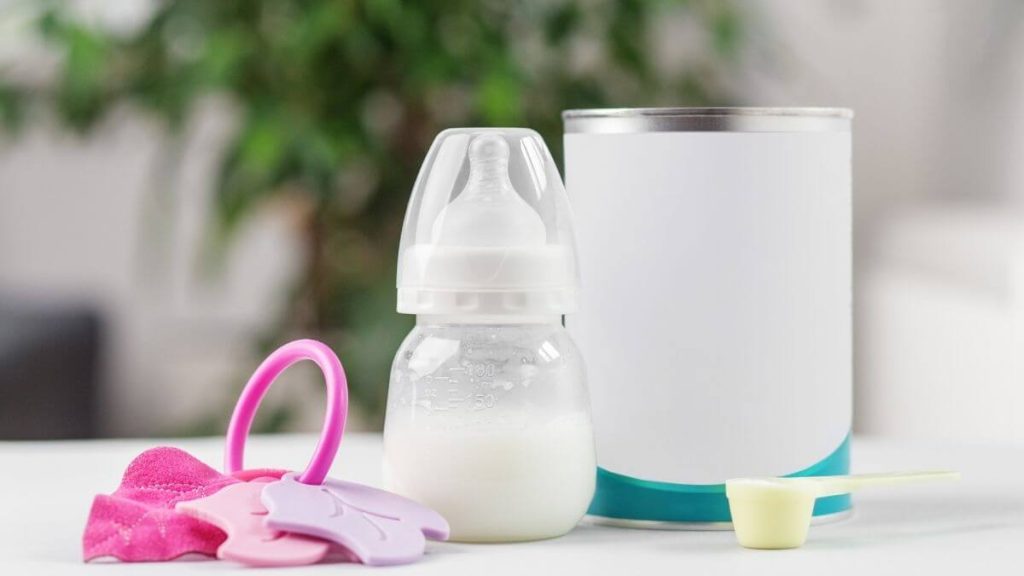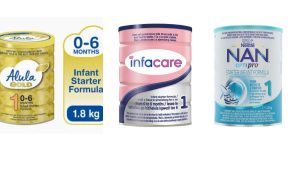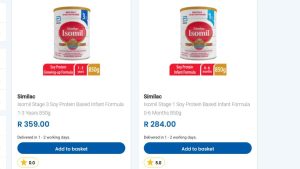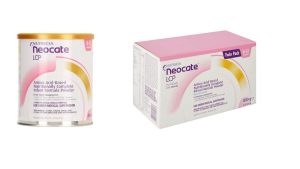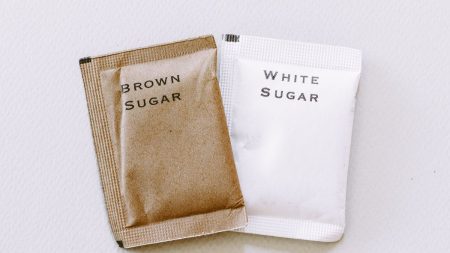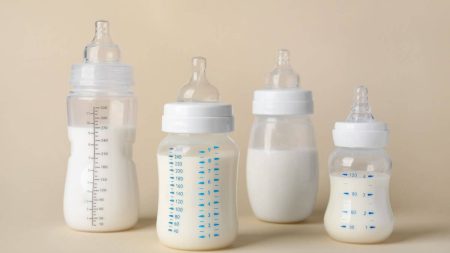Feeding your baby is one of the biggest responsibilities for new parents. Formula often plays an important role, whether because breastfeeding isn’t possible, you’re combining feeding methods, or formula is the most practical choice for your family.
But even after choosing a brand, there may come a time when you need to switch. This can feel stressful. Many parents wonder: Will a new formula upset my baby’s tummy? Will they reject it? Is it safe to change?
The reality is that switching baby formula is common and safe when done correctly. Parents in South Africa, especially those relying on SASSA grants, often face challenges like high prices, shortages in local stores, or a baby developing allergies or intolerances. A switch may also be necessary as your child grows and their needs change.
The key is to make changes gradually and with guidance. A baby’s digestive system is still developing, and sudden changes can cause discomfort. With the right knowledge and support from healthcare providers, you can help your little one transition smoothly.
This guide will explain why and when to switch formula, how to do it safely, and what to watch for. By the end, you’ll feel informed and confident about making the right choice for your baby’s health and comfort.
Understanding Baby Formulas: Categories, Examples, Prices & Where to Buy
1.
These are the most common and widely available formulas, suitable for most healthy, full-term infants. They are designed to closely resemble breast milk in composition.
Note: Prices are approximate and may vary by retailer.
2. Soy-Based Formulas
Made from soy protein isolate and lactose-free, these formulas are sometimes chosen for families who prefer a plant-based option or if a baby shows lactose sensitivity. However, some babies with cow’s milk protein allergy (CMPA) may also react to soy. Always consult your doctor first.
Note: Prices are approximate and may vary by retailer.
3. Hydrolysed Formulas
These formulas have proteins that are broken down into smaller particles, making digestion easier. They are used for babies with allergies, colic, or difficulty tolerating standard formulas.
| Brand & Product | Price (R) | Where to Buy |
|---|---|---|
| Alula S-26 Gold Comfort (900g) | 379.90 | Clicks |
| Nestlé Nan Special Pro HA (800g) | 399.99 | Dis-chem |
| Nestlé Nan Special Pro Extra Comfort 3 (800g) | 359.00 | Clicks |
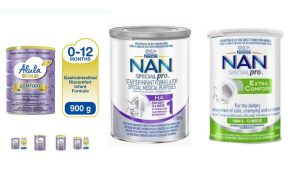
Note: Prices are approximate and may vary by retailer.
4. Lactose-Free Formulas
Designed for babies who cannot digest lactose, the sugar in cow’s milk. Lactose intolerance in infants is rare but can occur temporarily after diarrhoea or illness.
| Brand & Product | Price (R) | Where to Buy |
|---|---|---|
| Nestlé Nan Lactose-Free (400g) | 236.99 | Dis-chem |
| Nestlé Lactogen Stage 1 (1.8kg) | 289.00 | Clicks |
| Nestlé Lactogen Stage 2 (1.8kg) | 289.00 | Clicks |
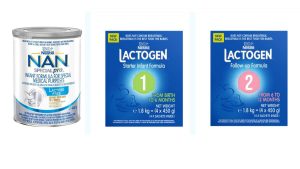
Note: Prices are approximate and may vary by retailer.
5. Specialised Formulas
For unique conditions such as reflux, premature babies, or severe allergies. Usually only available via prescription.
Note: Prices are approximate and may vary by retailer.
Key Insight: All formulas sold in South Africa meet safety standards regulated by the Department of Health. Cheaper doesn’t mean unsafe — it simply means fewer “premium” additives or marketing extras.
When to Consider a Formula Change
It’s natural for new parents to worry when their baby cries or struggles with feeding. However, not every tear or fussy moment means the formula is the problem. In the early months, babies’ digestive systems are still developing, and many common issues — such as mild gas, spitting up, or irregular stools — are temporary and often resolve on their own.
That said, there are situations where a formula change may be necessary. Recognising the difference between normal adjustment and a sign of intolerance is key.
Digestive Symptoms
Persistent diarrhoea or constipation: Occasional changes in stool are normal, but ongoing diarrhoea or painful constipation should not be ignored. This may mean your baby is struggling to process certain ingredients.
Gas and reflux: All babies burp and spit up, but constant discomfort or excessive reflux that doesn’t improve with feeding techniques (like burping or upright positioning) may signal sensitivity to the current formula.
Skin Symptoms
Rashes, eczema, hives, or swelling: If skin reactions appear soon after feeds, your baby may be experiencing an allergic response to proteins in the formula. Allergic reactions can worsen with repeated exposure, so medical guidance is crucial.
Respiratory Symptoms
Wheezing, coughing, or congestion: Breathing difficulties after feeding are red flags for allergies, particularly cow’s milk protein allergy (CMPA). These symptoms require urgent medical assessment.
Growth Concerns
Poor weight gain: If your baby isn’t growing at the expected rate despite regular feeds, the formula may not be providing what they need. Healthcare providers will assess this using growth charts at clinic visits.
Excessive Fussiness
Unusual crying or irritability: Some babies cry more than others, but if your child is consistently inconsolable after feeds — even with soothing, burping, and positioning — the formula could be contributing to their discomfort.
Situational Reasons for Switching
Not all changes are about allergies or intolerances. Sometimes, life circumstances make switching necessary:
Affordability: Baby formula is expensive, and for families living on a SASSA grant, balancing nutrition with budget is a constant challenge. If your current formula becomes too costly, your healthcare provider can recommend safe alternatives that still meet nutritional standards. Importantly, all formulas sold in South Africa must comply with strict health regulations, so lower-cost options are not unsafe.
Availability: Local stores and pharmacies sometimes run out of certain brands. Parents may also move to new areas where preferred formulas aren’t sold. In these cases, learning how to switch safely ensures your baby receives consistent nutrition without tummy upset.
Medical advice: Healthcare professionals may recommend switching to a specialised formula for medical conditions like reflux, lactose intolerance, or CMPA. Following professional guidance ensures your baby gets exactly what they need.
Key Reassurance for Parents
Changing your baby’s formula should never feel like failure. Babies are individuals, and what works for one child may not work for another. The decision to switch is not about “getting it wrong” — it’s about responding to your baby’s unique needs and circumstances with care.
Consulting a Professional
Before changing formulas, always consult a healthcare professional. Why? Because not all feeding issues are linked to formula. A baby may be struggling because of feeding technique, bottle nipple size, or even positioning.
Who can you consult in South Africa?
General practitioners (GPs): Provide advice on formula options and prescribe specialised formulas if needed.
Clinic nurses: Available at government clinics, especially important for families on SASSA grants.
Dietitians: Offer detailed nutrition advice for babies with complex needs.
Pro tip: Always keep a record of your baby’s feeding patterns and symptoms (a simple notebook or phone notes) to share with your healthcare provider.
How to Switch Safely
Switching baby formulas is not about grabbing a new tin and replacing the old one straight away. Babies have delicate digestive systems that are still learning how to process nutrients, so a sudden change can overwhelm them. That’s why experts recommend a gradual transition method. This gentle approach allows your baby’s tummy to adapt slowly, reduces the risk of digestive upsets, and increases the chances that your baby will accept the new taste and texture of the formula.
Step-by-Step Transition Plan
Day 1–2: Prepare bottles using ¾ of the old formula and ¼ of the new formula. This small change introduces your baby’s tummy to the new product.
Day 3–4: Move to a half-and-half mix — ½ old formula, ½ new formula. At this point, your baby is adjusting to the taste and digestion is adapting.
Day 5–6: Increase to ¾ new formula and ¼ old formula. Your baby’s digestive system should now be mostly comfortable with the new brand.
Day 7: Switch to 100% new formula. By now, most babies are fully transitioned without major discomfort.
This plan is widely recommended by paediatricians and dietitians because it balances caution with progress. For sensitive babies, some parents extend each stage to three days instead of two, making the full switch over 10–14 days.
Monitor Closely
Every baby reacts differently, so keeping track of changes is essential. A feeding diary helps you and your healthcare provider spot patterns. Record the following daily:
Number of feeds and amount taken: Are they drinking more or less than before?
Mood before and after feeding: Are they fussier or calmer than usual?
Stool consistency and frequency: Note changes in colour, texture, or frequency. Temporary changes are normal, but extreme differences should be flagged.
Sleep patterns: Sometimes tummy discomfort affects how long or well your baby sleeps.
Even a simple notebook or a note-taking app on your phone works well. Sharing this information at clinic visits gives professionals a clearer picture of your baby’s adjustment.
Dos and Don’ts
Do:
Wash your hands before preparing bottles.
Sterilise bottles, teats, and utensils after each use. Germs can upset sensitive tummies.
Measure formula exactly as per tin instructions. Too much powder can strain the kidneys, while too little may not provide enough nutrition.
Store prepared bottles safely. Use within one hour at room temperature, or refrigerate immediately if you’re preparing in advance.
Don’t:
Dilute formula to make it last longer. This is unsafe because it reduces the nutrients your baby receives.
Switch brands without medical advice if your baby has allergies, CMPA, or reflux.
Mix different formulas in the same scoop. Always prepare them separately according to the instructions, then combine if you are in the gradual transition stage.
Use expired formula or tins that have been open longer than recommended (usually one month after opening).
Extra Tips for a Smooth Transition
Introduce the new formula during the day rather than at night, so you can observe your baby’s response more closely.
Stay calm and patient — babies sense stress, and making feeding a relaxed experience can help them accept changes more easily.
Don’t introduce other major changes (like starting solids or changing bottles) at the same time. Give your baby one adjustment to focus on.
Seek support from clinic nurses or parenting groups if you feel unsure — you’re not alone in this journey.
Most babies adapt to a new formula within 5–10 days. If your baby struggles beyond two weeks, or if you notice concerning symptoms like blood in the stool, severe vomiting, or a rash, stop the new formula and seek medical advice immediately.
What to Expect During Transition
Even with a careful plan, some symptoms are common:
Temporary gas.
Slight fussiness.
Small changes in stool colour or texture.
But you should stop and seek medical advice if you notice:
Blood in stool.
Severe vomiting.
Rashes or swelling.
Difficulty breathing.
Remember, babies are resilient — most adjust to a new formula within a week or two.
Feeding Tips for Sensitive Tummies
A formula switch is smoother when supported by good feeding habits:
Sterilisation: Always sterilise bottles and teats until at least 12 months.
Feeding position: Hold your baby upright, not lying flat, to reduce reflux.
Burping: Burp halfway through and after each feed.
Paced feeding: Let your baby suck slowly, pausing to swallow.
Feeding diary: Track reactions to catch any intolerance early.
Allergy and Intolerance Awareness
Cow’s Milk Protein Allergy (CMPA)
Symptoms: Rash, vomiting, diarrhoea, colic, poor growth.
Treatment: Extensively hydrolysed or amino acid-based formula (doctor prescribed).
Lactose Intolerance
Symptoms: Gas, bloating, diarrhoea.
Often temporary after stomach bugs.
Treatment: Lactose-free formula (short term or as advised).
Soy Sensitivity
Some babies allergic to cow’s milk protein also react to soy. Always check with a healthcare provider.
Budget and Accessibility Considerations
Formula costs are a challenge for many families. On a SASSA grant, budgeting is crucial:
Buy locally: South African brands are affordable and meet strict safety standards.
Bulk buy: Larger tins are often cheaper per gram.
Shop smart: Check pharmacies, supermarkets, and online specials.
Clinic support: Some government clinics provide formula in special cases.
Avoid unsafe practices: Never make homemade formula or water down feeds.
Read more: Baby Formula Price Comparison — NAN, Lactogen & Infacare (October 2025)
Myths vs Facts
Myth 1: Switching baby formula always harms babies.
Many parents worry that changing a formula will upset their baby’s tummy or cause long-term harm. This belief often prevents families from making necessary changes when their baby is clearly uncomfortable or when formula shortages occur.
Fact:
When done gradually, most babies adjust to a new formula within a week without lasting issues.
Paediatricians and the South African Paediatric Association recommend the step-by-step transition method (gradually mixing old and new formula) to avoid tummy upsets.
Some fussiness, gas, or stool changes may occur temporarily, but these usually settle as the baby adapts.
Evidence: A review published in the Journal of Paediatrics and Child Health (2018) found that gradual formula transitions significantly reduced digestive disturbances compared to abrupt switches.
Myth 2: Expensive imported formulas are better.
South African parents sometimes feel pressured to buy costly imported brands, thinking these provide superior nutrition. This belief can cause financial strain, especially for families on SASSA grants, who may feel guilty if they cannot afford “premium” brands.
Fact:
All infant formulas sold in South Africa — whether imported or locally produced — must meet strict Department of Health regulations (R991 Regulations on Foodstuffs for Infants and Young Children).
Cheaper local brands like Infacare, Lactogen, or S26 are nutritionally complete and safe for babies.
“Premium” labels often mean extra marketing, added ingredients (such as probiotics or DHA), or packaging differences, but they are not essential for every baby.
The World Health Organization (WHO) states that standard cow’s milk-based infant formula provides sufficient nutrition for most babies who are not breastfed. Premium formulas are not necessary unless prescribed for medical reasons.
Myth 3: Formula causes allergies.
Some parents believe formula itself “creates” allergies, especially when their baby develops rashes or digestive issues after feeding. This myth can make parents feel guilty about choosing formula feeding.
Fact:
Allergies are caused by an immune system reaction to specific proteins, most commonly cow’s milk protein.
Babies who are genetically predisposed (family history of eczema, asthma, or allergies) are more likely to develop formula-related sensitivities.
Formula feeding does not “cause” allergies — it only reveals them in babies who are already prone.
Specialised formulas (hydrolysed or amino acid-based) exist to manage these cases safely.
Evidence: The American Academy of Pediatrics (AAP) confirms that formula does not create allergies. Instead, genetics and environmental factors play the biggest role in whether an infant develops CMPA (cow’s milk protein allergy).
Myth 4: You should never change formula once you’ve started.
This is another common worry. Parents are told that once they pick a formula, they must stick to it for the first year.
Fact:
Babies’ needs change over time. Switching from “starter” (Stage 1) to “follow-on” (Stage 2) formula after six months is standard practice.
If a baby develops intolerance or the formula becomes unavailable, switching is both safe and necessary.
What matters most is that transitions are done gradually and with healthcare guidance.
Expert Guidance and Parent Voices
Paediatrician advice: “Trust the process. Switching formulas is safe when done gradually under supervision.”
Parent voice (Durban): “When our formula went out of stock, we had to change. By mixing slowly, my baby adjusted in one week.”
Parent voice (Johannesburg, SASSA grant): “Budget was a concern. Our clinic nurse helped us choose a safe, affordable formula.”
Read more: How to Help Your Baby Sleep: Expert Tips for New Moms and Dads
Switching baby formula may seem stressful, but with the right knowledge and support, it can be a safe, smooth process. Every baby is unique — what works for one may not work for another. The secret lies in going slowly, observing closely, and consulting professionals.
For South African families, especially those living on SASSA support, safe and affordable formula options are available. The goal is always the same: a happy, healthy baby with a comfortable tummy, and a confident parent who feels reassured in their choices.







